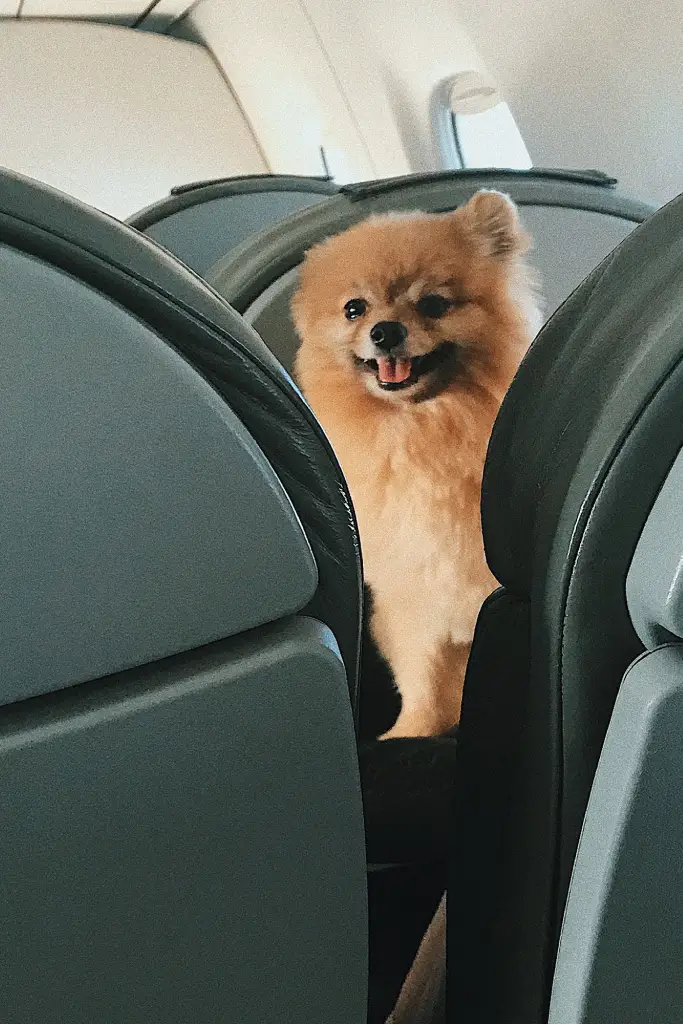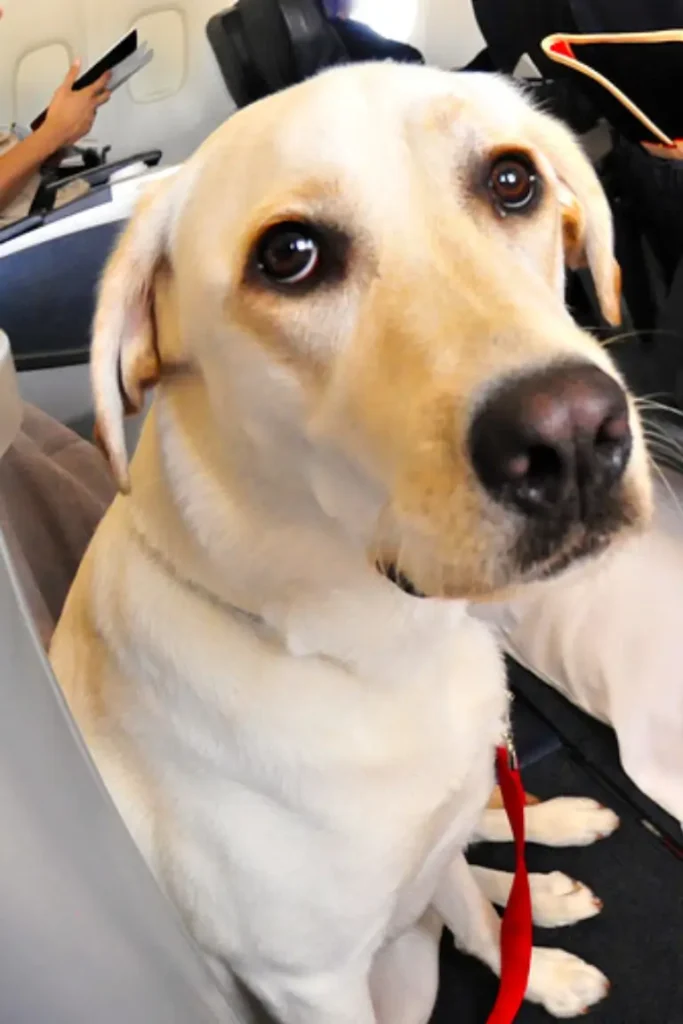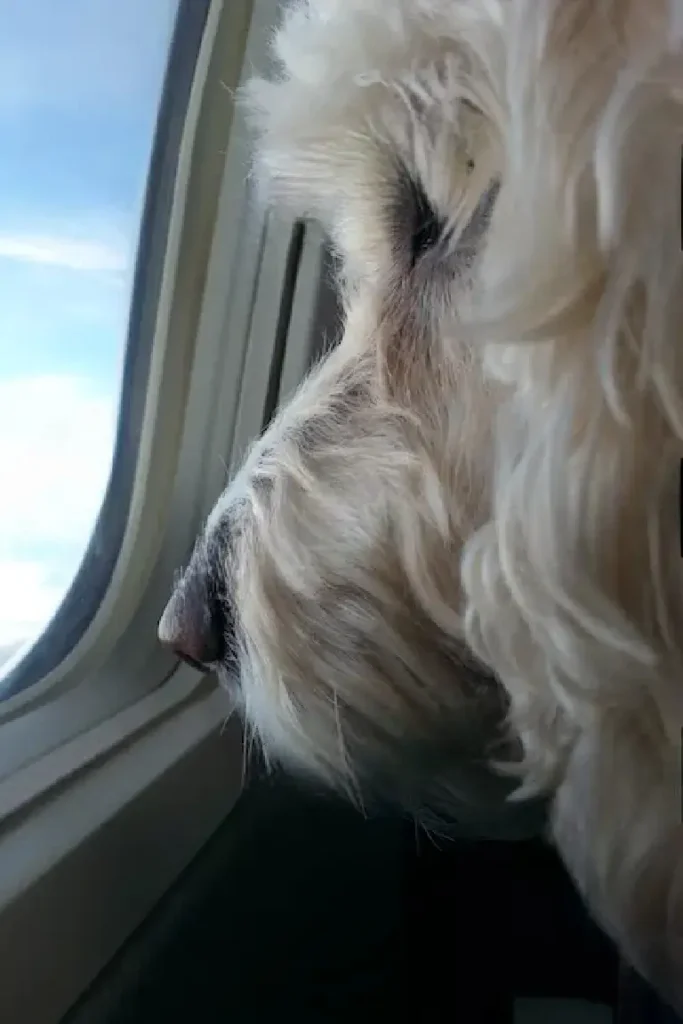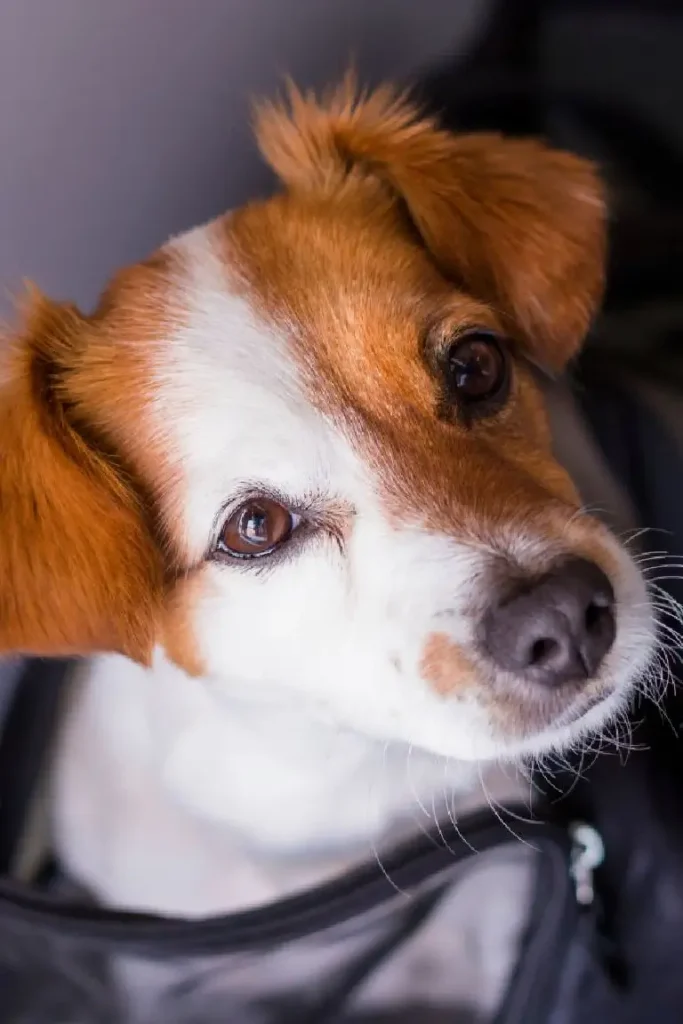Getting your dog’s carrier through airport security can be stressful and confusing.
You don’t want to end up with a carrier that’s too small, too big, or not approved by the airline.
In this post, we’ll look specifically at major U.S. airline rules for large dog carriers.
You’ll also learn what dimensions work for different airlines, along with our top picks for stylish, comfortable, and TSA-friendly options.
Stick with me until the end!
Key Takeaways
- The maximum dimensions for soft sided carriers are generally 18″ x 11″ x 11″ or smaller. For hard-sided kennels, the typical limit is 17.5” x 12” x 7.5”.
- However, each airline has specific requirements that must be followed. Be sure to check with your airline before purchasing a compliant pet carrier.
- Opt for a carrier that meets the size limits to maximize space for your pet. Measure carefully.
- Sturdy plastic or soft-sided kennels with adequate ventilation provide the most secure and comfortable pet experience in flight.

Furrtrekker is reader-supported. I may earn a small commission through these links. For more details, please read our privacy policy.
What is an Airline-Approved Pet Carrier?
An airline-approved pet carrier refers to a carrier that meets the size, weight limit, structure, and ventilation requirements set by individual airlines for in-cabin pet travel.
While dimensions may differ slightly between airlines, a soft-sided pet carrier must be 18” x 11” x 11” or smaller.
Hard kennels tend to have stricter size limits, usually around 17.5” x 12” x 7.5”.
Beyond pet’s size, airline-approved carriers must also:
- Be well-ventilated with mesh paneling for airflow
- Have accessible zippers or doors for easy pet loading
- Be constructed with leak-proof, durable materials
- Allow the pet to stand up and turn around inside
These size restrictions are in place for good reason – to avoid impeding other passengers or blocking aisles in the main cabin.
Though it may be tempting to push the limits, airlines do enforce them fairly strictly in my experience.
What Is the Largest Carrier Allowed on a Plane?
Generally, the maximum dimensions for soft-sided carriers are 18″ x 11″ x 11″ or smaller. For hard-sided kennels, the typical limit is 17.5” x 12” x 7.5”.
Airline pet carrier rules serve an important purpose – safety and comfort for all. So choosing one that aligns is very important.
The good news is most domestic flights allow small cats and dogs to fly in-cabin when properly contained.
Which Airline Allows Largest Dog Travel Carrier?
When I was preparing for a cross-country vacation with my husky, Four, I knew I needed an airline-approved travel carrier that would keep him comfortable for long distances.
Of the major U.S. airlines, American Airlines tends to have the most generous size allowances for carry-on pets.
For soft-sided carriers, the maximum dimensions are 18” L x 11” W x 11” H– giving pets a bit more room to stretch out.
They also permit hard-sided kennels up to 19” L x 13” W x 9” H but only for pets traveling in the cabin.
However, rules aren’t identical across airlines.
What the “largest” for United might be a no-go for other domestic or commercial airlines.
Let’s take a look at some common size restrictions you need to be aware of.
General Size Restrictions for In-Cabin Pet Carriers
The specific maximum dimensions for airline pet carriers vary slightly for each individual airline:
Delta
- Let’s start with Delta since they’re one of the largest domestic airlines.
- For those of you with smaller dogs, Delta recommends a soft-sided carrier no larger than 18 inches long, 11 inches wide, and 11 inches high. (This size – 18″x11″x11″ – works for most of their aircraft.)
United Airlines
- Moving on, United allows soft-sided pet carriers up to 18″ L x 11″ W x 11″ H and hard-sided kennels up to 17.5″ L x 12″ W x 7.5″ H.
American Airlines
- On American Airlines flights, soft-sided carriers must be no larger than 18″ L x 11″ W x 11″ H.
- While the maximum hard-sided kennel size is 19” L x 13” W x 9” H for mainline flights on American. Regional flights on American Eagle, on the other hand, must be no bigger than 16” L x 12” W x 8” H.
Alaska Airlines
- Now, for all pet owners planning to fly in Alaska, they’re more specific than some of the other domestic flights.
- They allow a hard-sided carrier of 17 inches long, 11 inches wide, and 7.5 inches high.
- A soft-sided one that’s 17 inches long, 11 inches wide, and 9.5 inches high.
- Aside from that, I’ve found Alaska to be one of the pickier airlines when it comes to fitting under the airplane seat, so keep that in mind.
- Even if your carrier technically meets the size limits, the flight attendant may still ask you to stow it if any part sticks out.
Hawaiian Airlines
- They’re on the stricter side, permitting only hard-sided carriers that are 16 inches long, 10 inches wide, and 9.5 inches high. (So quite small)
- While soft-sided is 17 inches long, 11 inches wide, and 9.5 inches high.
- Plus, the maximum weight of your pet and carrier can’t tip the scales over 25 pounds.
- I discovered this the hard way when booking a flight with my large dog. I had to scramble to buy him a special carrier to meet Hawaiian’s strict requirements. So double check with them before you fly.
Southwest Airlines
- Southwest Airlines allows pet carriers on flights, as long as they meet the size requirements.
- Southwest sells its own branded carrier that is 17″ long x 10″ wide x 9.5″ high, but passengers can also use other carriers up to 18.5″ long x 13.5″ wide x 9.5″ high.
JetBlue
- JetBlue permits soft and hard-sided carriers up to 17″ Long x 12.5″ Wide x 8.5″ Height.
Travel Tips
As a general rule, if your dog or cat is sticking out or appearing crowded inside, opt for a larger carry-on bag. As long as you stay under the maximums.
So there’s quite a span between major airlines regulations. That’s why it’s so important to verify ahead of time rather than assume.
Take note some airlines likely to BAN certain crate types altogether, such as wire crates.
That is why I always recommend pet owners double-check pet policies before buying.
Restrictions not only vary from airline to airline but can change ANYTIME.
Call their customer service if you need help finding the most up-to-date guidelines.
To sum up, while the exact in-cabin carrier dimensions differ between airlines, most range between 16-19 inches long, 10-13 inches wide, and 7-11 inches high.
I just threw a lot of numbers and measurements at you.
So to make it easy, here’s a quick reference chart summarizing the size restrictions across some of the biggest US domestic airlines:
| Airline | Soft-Sided Carrier | Hard-Sided Carrier |
|---|---|---|
| Delta | 18″ x 11″ x 11″ | N/A |
| United | 18″ x 11″ x 11″ | 17.5″ x 12″ x 7.5″ |
| American | 18″ x 11″ x 11″ | 19″ x 13″ x 9″ |
| Alaska | 17″ x 11″ x 9.5″ | 17″ x 11″ x 7.5″ |
| Hawaiian | 17″ x 11″ x 9.5″ | 16″ x 10″ x 9.5″ |
| Southwest | 17″ x 10″ x 9.5″ | 17″ x 10″ x 9.5″ |
| JetBlue | 17″ x 12.5″ x 8.5″ | 17″ x 12.5″ x 8.5″ |
I know an inch here and there might not seem like much, but trust me – every bit of space helps keep your dog and cat comfy!
How to Measure Your Pet for a Travel Carrier
Now just because those dimensions are “approved,” that doesn’t always mean your pet will fit comfortably.
I’ve seen some anxious pups who still looked crammed in their carriers when pet parents tried to check in.
And then the gate agent doesn’t let them board. So be mindful of both your dog’s weight and the carrier dimensions.
But how do I know if my dog has ample room inside a carrier?
The best way to ensure your Fido has plenty of room is to take their measurements before booking your flight.
Following International Air Transport Association (IATA) guidelines is a good starting point to ensure your pooch will be allowed in-cabin on international flights.
IATA recommends measuring from the tip of your pet’s nose to the base of their tail for length.
For height, measure from the floor to the top of their head or ears, whichever is higher.
Then measure their width or shoulders for the widest part of their body.
- Length: From the tip of the nose to the base of tail.
- Height: Floor to the top of the head or ears.
- Width: Widest part of their body from shoulder to shoulder.
Travel Tips
Measure your pet while they are standing in a natural position. Additionally, it’s a good idea to add a couple of extra inches to the length and width measurements to give them adequate room to move around.
For height, ensure they can sit and stand fully upright with a few inches to spare.
If your measurements exceed the airline’s maximum by more than an inch or two, your pup may be too large to bring in the cabin.
You’ll then have to consider cargo area or ground transport options.
Top Picks Travel Carriers Recommended by Fur Parents
When selecting the best airline-approved pet carrier, your top priority should always be about pet safety.
As a fur parent myself, I want to ensure my dog has ample space to move around while also preventing potential injuries during travel.
Here I will share top-rated carrier recommendations from other loving pet owners based on size :
01. Wild One Travel Carrier
- Soft-sided and collapsible
- Mesh panels for ventilation
- Padded carry straps
- Interior tether and rear pocket
- 17.5” L x 11” W x 10” H maximum size
02. Petsfit Expandable Carrier
- Expandable side carrier
- Anti-scratch ventilated mesh
- Removable padded shoulder straps
- 17” L x 11” W x 11” H maximum size
03. Sherpa Original Deluxe Airline-Approved Dog Carrier
- Waterproof interior base
- Soft-sided and collapsible
- Mesh panels for ventilation
- Large storage pocket
- 19″ x 11.75″ x 11.5 maximum size
04. Sleepypod Air In-Cabin Pet Carrier
- Crash-tested
- Durable rip-stop mesh resists chewing or clawing
- Luggage strap for stacking
- Water-repellent interior liner
- 22” L x 10.5” W x 10.5” H maximum size
05. PetPeppy Expandable Carrier
- Soft-sided nylon carrier with a wire frame
- Ventilation holes with protective cover
- Latching door and handle
- Removable plush faux fleece bedding
- 18” L x 11” W x 11” H maximum size
06. Petmate Sky Kennel
- Hard-sided plastic kennel
- Ventilation holes and latching door
- Non-corrosive plastic wing nuts
- 48″ L x 32″ W x 35″ H maximum size
For small pets like kittens under 15 pounds, the Wild One Travel Carrier and Petsfit Expandable Pet Carrier are two of the best airline-approved cat carriers in the market.
Likewise, if you’ve got medium size cats and dogs between 15-20 pounds, larger sizes of the above models work nicely.
The Sherpa Original Deluxe Carrier and Sleepypod Air In-Cabin Pet Carrier also come in larger sizes to accommodate pets over 15 pounds.
For the largest breeds permitted in-cabin, consider PetPeppy Expandable carriers, able to hold pets up to 20 pounds.
Both feature durable, structured frames with mesh windows and foldable designs.
Now, if your large dog exceeds size limits for the cabin, the Petmate Sky Kennel is an excellent choice.
This airline-approved hard-sided kennel secures safely in cargo holds, keeping your dog comfortable on longer flights. Just be aware that you won’t be able to access your pet once onboard.
Tips for Choosing the Largest Airline-Compliant Carrier
The first thing to consider when choosing an airline-compliant carrier is your dog’s size.
Remember that a dog travel carrier is considered a personal item that must meet the pet carrier dimensions for under seat stowage.
So the right pet carrier you choose will depend on your pet’s measurements.
Personally, I prefer soft-sided bags with expandable panels to maximize usable room when needed.
These cozy, den-like carriers suit small size pets best. For large size breeds, sturdy hard kennel is the best option.
Here are some additional tips for choosing an airline-compliant carrier:
- Aim for soft-sided bags with expandable panels to maximize interior size.
- Pick a style with a wide, rounded base rather than narrow and rectangular.
- For height, a slanted-roof soft carrier allows more headroom when collapsed.
- Opt for just enough room to stand, turn, and lie down without excessive empty space.
- Bring a measuring tape with you when shopping to check dimensions.
- Let your pet try out a carrier before buying to ensure good fit.
Again, guys, it’s all about your pet’s needs. The right size airline-approved crate or bag will keep them cozy and secure throughout the flight.
Other Factors to Consider in Airline-Approved Travel Carriers
Size is just one of many things in choosing the best carrier. You also need to evaluate:
- Room to Move: Your pet needs to stretch out, stand, sit, and do a full 360-degree turn without hitting the walls. (treat it like their personal yoga space)
- Breathability: At least two sides of the carrier should be all about that mesh life, giving your dog plenty of fresh air.
- Easy In, Easy Out: Doors that are a cinch to open mean less stress for you and your pup when it’s time to board or disembark.
- Cozy Interior: We’re talking about soft padding and zero sharp bits that could invite a chew fest.
- Leak-Proof: A waterproof bottom is a must in case of accidents.
- Materials: Whether it’s sturdy fabric or solid plastic, the material should handle the hustle and bustle of travel.
- Handles/straps: Multiple carry options make transporting the bag easy.
- Carry On, Carry Easy: Good handles or straps are key for schlepping that carrier through terminals.
- Clean-Friendly: Removable liners that you can toss in the wash will keep things fresh.
Prioritizing these features along with size requirements will lead you to the best airline-approved carrier for airplane travel.
Booking Your Flight with a Pet in Cabin
All right. You found the perfect airline-approved carrier for your furry co-pilot. Now it’s time to book that pet-friendly flight.
Follow these tips for smooth travels from takeoff to touchdown:
- Reserve Early: Most airlines limit pets to just 2-5 per flight. Book well in advance to secure a spot. Thinking of flying in business class for extra legroom? Go for it! Just know you still need to buy an additional seat for your pet and fees may be higher than coach.
- Know the rules: Some ban snub-nosed (brachycephalic) breeds or certain busy travel days.
- Confirm under-seat space: Use online seat maps or call ahead to verify room.
- Attach ID tags: Include your contact info and destination address.
- Ask about bathroom breaks: Especially on longer flights.
- Pack carefully: Include food, medications, chew toys, and pads. You may need a health certificate from your vet.
- Watch the weather: Extreme temperatures may affect cargo hold policies.
- Request a window seat: Easier access to your pet during flight.
- Arrive Early: Allow extra time for pet check-in and TSA screening. Less rushing means less stress for both of you.
Again, guys, stay prepared and choose an airline-approved carrier designed for air travel.
Air Travel Options
For pets too large to fit in the cabin, airlines offer alternative solutions to get your furry friend to your destination.
Checked Pets
Most airlines allow dogs and cats to travel as checked baggage or cargo. This involves transporting the pet in the temperature-controlled luggage hold of the aircraft.
Checked pets must travel in USDA-approved rigid kennels that meet specific dimension and labeling rules. Costs are also higher – often $100-$200 each way.
This option is really only suitable for larger animals over 20 pounds. The cargo hold carries more risks and stress for your pet.
Shipping Pets as Cargo
Some airlines may require large dogs to be shipped through their live animal cargo program. This is in the baggage hold but under special handling procedures.
Rates are charged by weight, size, and distance. You must make cargo reservations in advance and have proper veterinary paperwork. An escort is also mandatory when dropping off and picking up the pet.
Shipping Pets with a Pet Relocation Company
For complex international moves, hiring a professional pet relocation service is advisable. They handle all the paperwork, kenneling, vet checks and airline arrangements. This reduces risks and stress for the animal.
Costs vary based on location and service level. But it’s often the safest option for valuable, fragile or very large pets.
Ground Transportation
For shorter distances within the U.S., ground transport may be the best solution. Options include:
- Driving: Ideal for shorter trips of 10 hours or less. Your pet stays with you.
- Train: Amtrak allows small dogs in carriers on many routes for $25 each way.
- Bus: Greyhound permits dogs or cats in carriers for a $10-20 pet fee.
- Pet shuttle vans: Private transport services catering to pets. More expensive but door-to-door.
FAQs
What is the largest dog carrier allowed on Delta Airlines flights?
The largest dog carrier allowed on Delta Airlines flights depends on whether your dog is flying in cabin or as checked baggage.
For carry-on pets flying in cabin, the carrier must fit completely under the seat in front of you.
Soft-sided collapsible carriers up to 18 x 11 x 11 inches are recommended.
For checked pets flying in cargo, Delta Airlines allows kennels up to 40 x 27 x 30 inches on flights to the United States, North America, United Kingdom, and Puerto Rico.
For flights to South Africa, the maximum kennel size is 36 x 24 x 26 inches.
Can I bring exotic animals on an American Airlines flight?
Unfortunately, American Airlines only allows dogs and cats to fly as pets in the cabin.
You have to leave your exotic ESAs like guinea pigs and household birds down in cargo terminals.
However, trained service animals like service dog and emotional support animals that provide disability assistance are permitted, with proper documentation.
More Travel Blogs:
Furrtrekker Travel Checklist
Packing List
Must-Have Carrier Accessories
- ID tags
- "Live Animal" sticker
- Collar, harness, and leash stored inside
- Bedding & pee pads
Cleaning Supplies
- Poop bags, wipes, & towels
- Small first aid kit
Travel Documents
- Health certificate from vet
- Up-to-date rabies vaccination records
- Breed verification form (if required by airline)
- Customer acknowledgement form (if required by airline)
- Airline pet policy
- Payment receipt as proof of pet ticket
- Vaccine records
- Emergency vet contact info
For Your Dog
- Prescription medications, if needed
- At least 2-3 meals' worth of dog food
- Collapsible food & water bowls
- Water bottle
- Bandana or blanket with your scent to comfort your dog
- Toys & their favorite treats
For You
- Print out of airline pet policy
- Payment confirmation that shows your dog is booked
- Photo of your dog
- List of contact info for your vet and local emergency vet
How to Organize and Pack
- The key is organization! Split items between your carry-on and checked baggage.
- Place all documents, your dog's or cat's food, bowls, treats, and the carrier in your carry-on bag so they are easily accessible.
- Pack extras like toys, bedding, and your scent bandana neatly in your checked baggage.
- Store medications, health records, and the airline policy printout separately in a folder or bag where they won't get lost.




